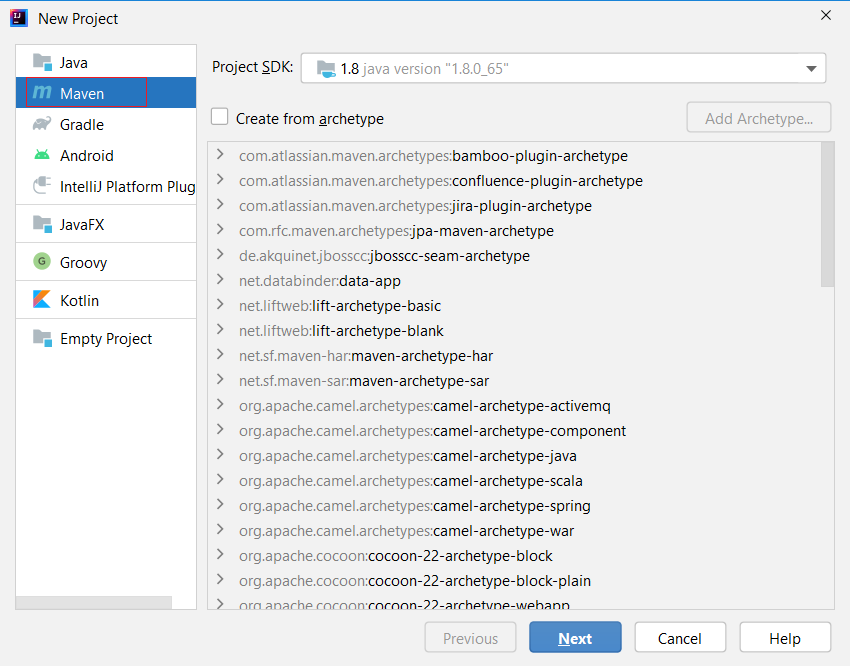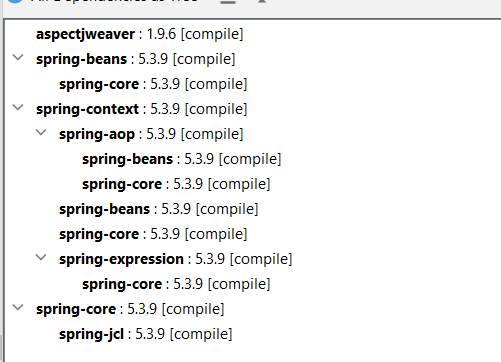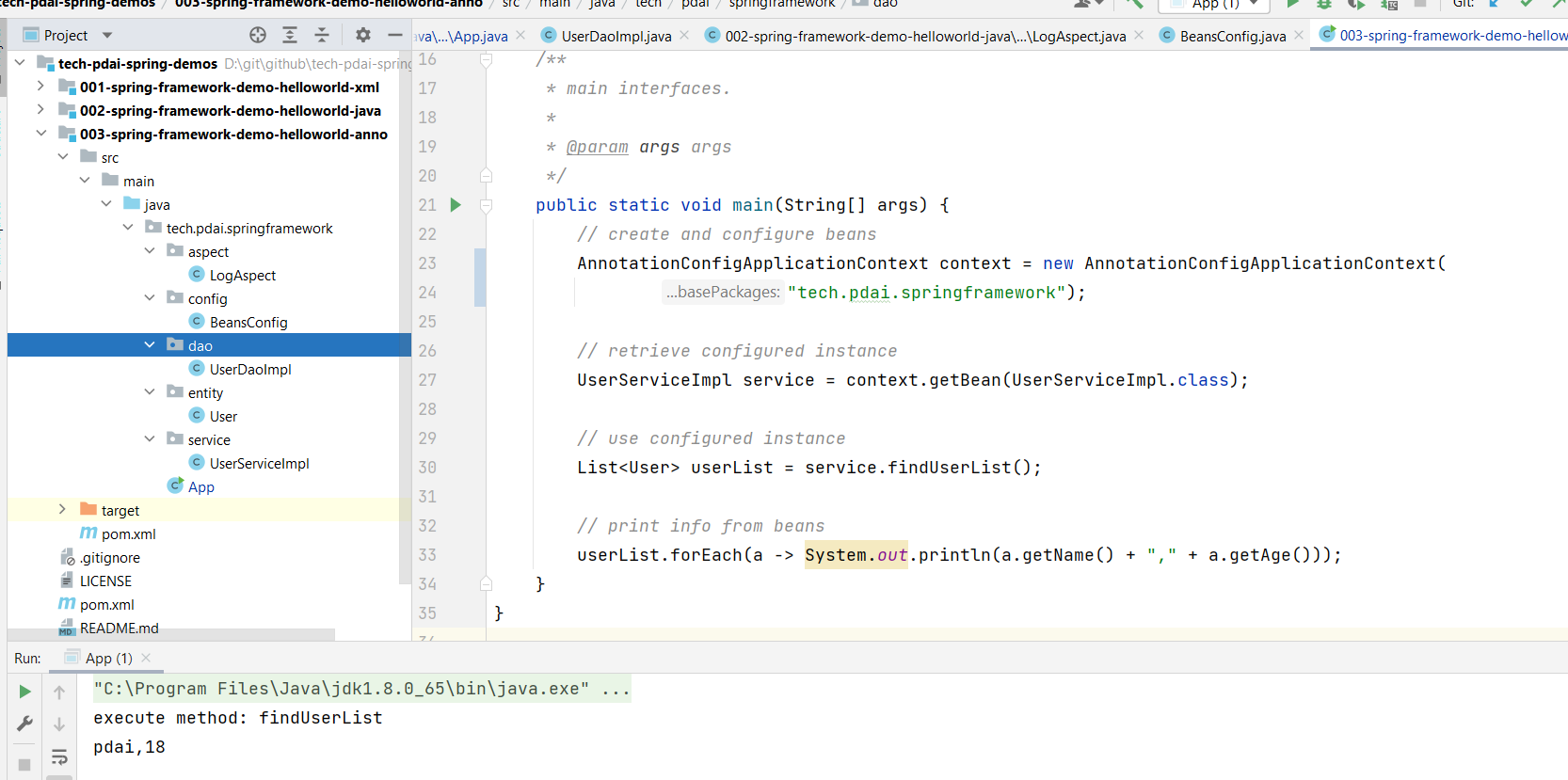Spring框架系列(2)
上文中我們簡單介紹了Spring和Spring Framework的元件,那麼這些Spring Framework元件是如何配合工作的呢?本文主要承接上文,向你展示Spring Framework元件的典型應用場景和基於這個場景設計出的簡單案例,並以此引出Spring的核心要點,比如IOC和AOP等;在此基礎上還引入了不同的設定方式, 如XML,Java設定和註解方式的差異。@pdai
Spring框架如何應用
上文中,我們展示了Spring和Spring Framework的元件, 這裡對於開發者來說有幾個問題:
- 首先,對於Spring進階,直接去看IOC和AOP,存在一個斷層,所以需要整體上構建對Spring框架認知上進一步深入,這樣才能構建知識體系。
- 其次,很多開發者入門都是從Spring Boot開始的,他對Spring整體框架底層,以及發展歷史不是很瞭解; 特別是對於一些老舊專案維護和底層bug分析沒有全域性觀。
- 再者,Spring代表的是一種框架設計理念,需要全域性上理解Spring Framework元件是如何配合工作的,需要理解它設計的初衷和未來趨勢。
如下是官方在解釋Spring框架的常用場景的圖

我加上一些註釋後,是比較好理解的;引入這個圖,重要的原因是為後面設計一個案例幫助你構建認知。
設計一個Spring的Hello World
結合上面的使用場景,設計一個查詢使用者的案例的兩個需求,來看Spring框架幫我們簡化了什麼開發工作:
- 查詢使用者資料 - 來看DAO+POJO-> Service 的初始化和裝載。
- 給所有Service的查詢方法記錄紀錄檔
- 建立一個Maven的Java專案

- 引入Spring框架的POM依賴,以及檢視這些依賴之間的關係
<?xml version="1.0" encoding="UTF-8"?>
<project xmlns="http://maven.apache.org/POM/4.0.0"
xmlns:xsi="http://www.w3.org/2001/XMLSchema-instance"
xsi:schemaLocation="http://maven.apache.org/POM/4.0.0 http://maven.apache.org/xsd/maven-4.0.0.xsd">
<modelVersion>4.0.0</modelVersion>
<groupId>tech.pdai</groupId>
<artifactId>001-spring-framework-demo-helloworld-xml</artifactId>
<version>1.0-SNAPSHOT</version>
<properties>
<maven.compiler.source>8</maven.compiler.source>
<maven.compiler.target>8</maven.compiler.target>
<spring.version>5.3.9</spring.version>
<aspectjweaver.version>1.9.6</aspectjweaver.version>
</properties>
<dependencies>
<dependency>
<groupId>org.springframework</groupId>
<artifactId>spring-context</artifactId>
<version>${spring.version}</version>
</dependency>
<dependency>
<groupId>org.springframework</groupId>
<artifactId>spring-core</artifactId>
<version>${spring.version}</version>
</dependency>
<dependency>
<groupId>org.springframework</groupId>
<artifactId>spring-beans</artifactId>
<version>${spring.version}</version>
</dependency>
<dependency>
<groupId>org.aspectj</groupId>
<artifactId>aspectjweaver</artifactId>
<version>${aspectjweaver.version}</version>
</dependency>
</dependencies>
</project>

- POJO - User
package tech.pdai.springframework.entity;
/**
* @author pdai
*/
public class User {
/**
* user's name.
*/
private String name;
/**
* user's age.
*/
private int age;
/**
* init.
*
* @param name name
* @param age age
*/
public User(String name, int age) {
this.name = name;
this.age = age;
}
public String getName() {
return name;
}
public void setName(String name) {
this.name = name;
}
public int getAge() {
return age;
}
public void setAge(int age) {
this.age = age;
}
}
- DAO 獲取 POJO, UserDaoServiceImpl (mock 資料)
package tech.pdai.springframework.dao;
import java.util.Collections;
import java.util.List;
import tech.pdai.springframework.entity.User;
/**
* @author pdai
*/
public class UserDaoImpl {
/**
* init.
*/
public UserDaoImpl() {
}
/**
* mocked to find user list.
*
* @return user list
*/
public List<User> findUserList() {
return Collections.singletonList(new User("pdai", 18));
}
}
並增加daos.xml
<?xml version="1.0" encoding="UTF-8"?>
<beans xmlns="http://www.springframework.org/schema/beans"
xmlns:xsi="http://www.w3.org/2001/XMLSchema-instance"
xsi:schemaLocation="http://www.springframework.org/schema/beans
http://www.springframework.org/schema/beans/spring-beans.xsd">
<bean id="userDao" class="tech.pdai.springframework.dao.UserDaoImpl">
<!-- additional collaborators and configuration for this bean go here -->
</bean>
<!-- more bean definitions for data access objects go here -->
</beans>
- 業務層 UserServiceImpl(呼叫DAO層)
package tech.pdai.springframework.service;
import java.util.List;
import tech.pdai.springframework.dao.UserDaoImpl;
import tech.pdai.springframework.entity.User;
/**
* @author pdai
*/
public class UserServiceImpl {
/**
* user dao impl.
*/
private UserDaoImpl userDao;
/**
* init.
*/
public UserServiceImpl() {
}
/**
* find user list.
*
* @return user list
*/
public List<User> findUserList() {
return this.userDao.findUserList();
}
/**
* set dao.
*
* @param userDao user dao
*/
public void setUserDao(UserDaoImpl userDao) {
this.userDao = userDao;
}
}
並增加services.xml
<?xml version="1.0" encoding="UTF-8"?>
<beans xmlns="http://www.springframework.org/schema/beans"
xmlns:xsi="http://www.w3.org/2001/XMLSchema-instance"
xsi:schemaLocation="http://www.springframework.org/schema/beans
http://www.springframework.org/schema/beans/spring-beans.xsd">
<!-- services -->
<bean id="userService" class="tech.pdai.springframework.service.UserServiceImpl">
<property name="userDao" ref="userDao"/>
<!-- additional collaborators and configuration for this bean go here -->
</bean>
<!-- more bean definitions for services go here -->
</beans>
- 攔截所有service中的方法,並輸出記錄
package tech.pdai.springframework.aspect;
import java.lang.reflect.Method;
import org.aspectj.lang.ProceedingJoinPoint;
import org.aspectj.lang.annotation.Around;
import org.aspectj.lang.annotation.Aspect;
import org.aspectj.lang.reflect.MethodSignature;
import org.springframework.context.annotation.EnableAspectJAutoProxy;
/**
* @author pdai
*/
@Aspect
public class LogAspect {
/**
* aspect for every methods under service package.
*/
@Around("execution(* tech.pdai.springframework.service.*.*(..))")
public Object businessService(ProceedingJoinPoint pjp) throws Throwable {
// get attribute through annotation
Method method = ((MethodSignature) pjp.getSignature()).getMethod();
System.out.println("execute method: " + method.getName());
// continue to process
return pjp.proceed();
}
}
並增加aspects.xml
<?xml version="1.0" encoding="UTF-8"?>
<beans xmlns="http://www.springframework.org/schema/beans"
xmlns:xsi="http://www.w3.org/2001/XMLSchema-instance"
xmlns:aop="http://www.springframework.org/schema/aop"
xmlns:context="http://www.springframework.org/schema/context"
xsi:schemaLocation="http://www.springframework.org/schema/beans
http://www.springframework.org/schema/beans/spring-beans.xsd
http://www.springframework.org/schema/aop
http://www.springframework.org/schema/aop/spring-aop.xsd
http://www.springframework.org/schema/context
http://www.springframework.org/schema/context/spring-context.xsd
">
<context:component-scan base-package="tech.pdai.springframework" />
<aop:aspectj-autoproxy/>
<bean id="logAspect" class="tech.pdai.springframework.aspect.LogAspect">
<!-- configure properties of aspect here as normal -->
</bean>
<!-- more bean definitions for data access objects go here -->
</beans>
- 組裝App
package tech.pdai.springframework;
import java.util.List;
import org.springframework.context.ApplicationContext;
import org.springframework.context.support.ClassPathXmlApplicationContext;
import tech.pdai.springframework.entity.User;
import tech.pdai.springframework.service.UserServiceImpl;
/**
* @author pdai
*/
public class App {
/**
* main interfaces.
*
* @param args args
*/
public static void main(String[] args) {
// create and configure beans
ApplicationContext context =
new ClassPathXmlApplicationContext("aspects.xml", "daos.xml", "services.xml");
// retrieve configured instance
UserServiceImpl service = context.getBean("userService", UserServiceImpl.class);
// use configured instance
List<User> userList = service.findUserList();
// print info from beans
userList.forEach(a -> System.out.println(a.getName() + "," + a.getAge()));
}
}
- 整體結構和執行app

這個例子體現了Spring的哪些核心要點
那麼Spring框架幫助我們做什麼,它體現了什麼哪些要點呢?
控制反轉 - IOC
來看第一個需求:查詢使用者(service通過呼叫dao查詢pojo),本質上如何建立User/Dao/Service等;
- 如果沒有Spring框架,我們需要自己建立User/Dao/Service等,比如:
UserDaoImpl userDao = new UserDaoImpl();
UserSericeImpl userService = new UserServiceImpl();
userService.setUserDao(userDao);
List<User> userList = userService.findUserList();
- 有了Spring框架,可以將原有Bean的建立工作轉給框架, 需要用時從Bean的容器中獲取即可,這樣便簡化了開發工作
Bean的建立和使用分離了。
// create and configure beans
ApplicationContext context =
new ClassPathXmlApplicationContext("aspects.xml", "daos.xml", "services.xml");
// retrieve configured instance
UserServiceImpl service = context.getBean("userService", UserServiceImpl.class);
// use configured instance
List<User> userList = service.findUserList();

更進一步,你便能理解為何會有如下的知識點了:
- Spring框架管理這些Bean的建立工作,即由使用者管理Bean轉變為框架管理Bean,這個就叫控制反轉 - Inversion of Control (IoC)
- Spring 框架託管建立的Bean放在哪裡呢? 這便是IoC Container;
- Spring 框架為了更好讓使用者設定Bean,必然會引入不同方式來設定Bean? 這便是xml設定,Java設定,註解設定等支援
- Spring 框架既然接管了Bean的生成,必然需要管理整個Bean的生命週期等;
- 應用程式程式碼從Ioc Container中獲取依賴的Bean,注入到應用程式中,這個過程叫 依賴注入(Dependency Injection,DI) ; 所以說控制反轉是通過依賴注入實現的,其實它們是同一個概念的不同角度描述。通俗來說就是IoC是設計思想,DI是實現方式
- 在依賴注入時,有哪些方式呢?這就是構造器方式,@Autowired, @Resource, @Qualifier... 同時Bean之間存在依賴(可能存在先後順序問題,以及迴圈依賴問題等)
這邊引入我們後續的相關文章:Spring基礎 - Spring之控制反轉(IOC)
面向切面 - AOP
來看第二個需求:給Service所有方法呼叫新增紀錄檔(呼叫方法時),本質上是解耦問題;
- 如果沒有Spring框架,我們需要在每個service的方法中都新增記錄紀錄檔的方法,比如:
/**
* find user list.
*
* @return user list
*/
public List<User> findUserList() {
System.out.println("execute method findUserList");
return this.userDao.findUserList();
}
- 有了Spring框架,通過@Aspect註解 定義了切面,這個切面中定義了攔截所有service中的方法,並記錄紀錄檔; 可以明顯看到,框架將紀錄檔記錄和業務需求的程式碼解耦了,不再是侵入式的了
/**
* aspect for every methods under service package.
*/
@Around("execution(* tech.pdai.springframework.service.*.*(..))")
public Object businessService(ProceedingJoinPoint pjp) throws Throwable {
// get attribute through annotation
Method method = ((MethodSignature) pjp.getSignature()).getMethod();
System.out.println("execute method: " + method.getName());
// continue to process
return pjp.proceed();
}
更進一步,你便能理解為何會有如下的知識點了:
- Spring 框架通過定義切面, 通過攔截切點實現了不同業務模組的解耦,這個就叫面向切面程式設計 - Aspect Oriented Programming (AOP)
- 為什麼@Aspect註解使用的是aspectj的jar包呢?這就引出了Aspect4J和Spring AOP的歷史淵源,只有理解了Aspect4J和Spring的淵源才能理解有些註解上的相容設計
- 如何支援更多攔截方式來實現解耦, 以滿足更多場景需求呢? 這就是@Around, @Pointcut... 等的設計
- 那麼Spring框架又是如何實現AOP的呢? 這就引入代理技術,分靜態代理和動態代理,動態代理又包含JDK代理和CGLIB代理等
這邊引入我們後續的相關文章:Spring基礎 - Spring之面向切面程式設計(AOP)
Spring框架設計如何逐步簡化開發的
通過上述的框架介紹和例子,已經初步知道了Spring設計的兩個大的要點:IOC和AOP;從框架的設計角度而言,更為重要的是簡化開發,比如提供更為便捷的設定Bean的方式,直至0設定(即約定大於設定)。這裡我將通過Spring歷史版本的發展,和SpringBoot的推出等,來幫你理解Spring框架是如何逐步簡化開發的。
Java 設定方式改造
在前文的例子中, 通過xml設定方式實現的,這種方式實際上比較麻煩; 我通過Java設定進行改造:
- User,UserDaoImpl, UserServiceImpl,LogAspect不用改
- 將原通過.xml設定轉換為Java設定
package tech.pdai.springframework.config;
import org.springframework.context.annotation.Bean;
import org.springframework.context.annotation.Configuration;
import org.springframework.context.annotation.EnableAspectJAutoProxy;
import tech.pdai.springframework.aspect.LogAspect;
import tech.pdai.springframework.dao.UserDaoImpl;
import tech.pdai.springframework.service.UserServiceImpl;
/**
* @author pdai
*/
@EnableAspectJAutoProxy
@Configuration
public class BeansConfig {
/**
* @return user dao
*/
@Bean("userDao")
public UserDaoImpl userDao() {
return new UserDaoImpl();
}
/**
* @return user service
*/
@Bean("userService")
public UserServiceImpl userService() {
UserServiceImpl userService = new UserServiceImpl();
userService.setUserDao(userDao());
return userService;
}
/**
* @return log aspect
*/
@Bean("logAspect")
public LogAspect logAspect() {
return new LogAspect();
}
}
- 在App中載入BeansConfig的設定
package tech.pdai.springframework;
import java.util.List;
import org.springframework.context.annotation.AnnotationConfigApplicationContext;
import tech.pdai.springframework.config.BeansConfig;
import tech.pdai.springframework.entity.User;
import tech.pdai.springframework.service.UserServiceImpl;
/**
* @author pdai
*/
public class App {
/**
* main interfaces.
*
* @param args args
*/
public static void main(String[] args) {
// create and configure beans
AnnotationConfigApplicationContext context = new AnnotationConfigApplicationContext(BeansConfig.class);
// retrieve configured instance
UserServiceImpl service = context.getBean("userService", UserServiceImpl.class);
// use configured instance
List<User> userList = service.findUserList();
// print info from beans
userList.forEach(a -> System.out.println(a.getName() + "," + a.getAge()));
}
}
- 整體結構和執行app

註解設定方式改造
更進一步,Java 5開始提供註解支援,Spring 2.5 開始完全支援基於註解的設定並且也支援JSR250 註解。在Spring後續的版本發展傾向於通過註解和Java設定結合使用.
- BeanConfig 不再需要Java設定
package tech.pdai.springframework.config;
import org.springframework.context.annotation.ComponentScan;
import org.springframework.context.annotation.ComponentScans;
import org.springframework.context.annotation.Configuration;
import org.springframework.context.annotation.EnableAspectJAutoProxy;
/**
* @author pdai
*/
@Configuration
@EnableAspectJAutoProxy
public class BeansConfig {
}
- UserDaoImpl 增加了 @Repository註解
/**
* @author pdai
*/
@Repository
public class UserDaoImpl {
/**
* mocked to find user list.
*
* @return user list
*/
public List<User> findUserList() {
return Collections.singletonList(new User("pdai", 18));
}
}
- UserServiceImpl 增加了@Service 註解,並通過@Autowired注入userDao.
/**
* @author pdai
*/
@Service
public class UserServiceImpl {
/**
* user dao impl.
*/
@Autowired
private UserDaoImpl userDao;
/**
* find user list.
*
* @return user list
*/
public List<User> findUserList() {
return userDao.findUserList();
}
}
- 在App中掃描tech.pdai.springframework包
package tech.pdai.springframework;
import java.util.List;
import org.springframework.context.annotation.AnnotationConfigApplicationContext;
import tech.pdai.springframework.entity.User;
import tech.pdai.springframework.service.UserServiceImpl;
/**
* @author pdai
*/
public class App {
/**
* main interfaces.
*
* @param args args
*/
public static void main(String[] args) {
// create and configure beans
AnnotationConfigApplicationContext context = new AnnotationConfigApplicationContext(
"tech.pdai.springframework");
// retrieve configured instance
UserServiceImpl service = context.getBean(UserServiceImpl.class);
// use configured instance
List<User> userList = service.findUserList();
// print info from beans
userList.forEach(a -> System.out.println(a.getName() + "," + a.getAge()));
}
}
- 整體結構和執行app

SpringBoot託管設定
Springboot實際上通過約定大於設定的方式,使用xx-starter統一的對Bean進行預設初始化,使用者只需要很少的設定就可以進行開發了。
這個因為很多開發者都是從SpringBoot開始著手開發的,所以這個比較好理解。我們需要的是將知識點都串聯起來,構築認知體系。
結合Spring歷史版本和SpringBoot看發展
最後結合Spring歷史版本總結下它的發展:
(這樣是不是能夠幫助你在整體上構建了知識體系的認知了呢?)

PS:相關程式碼,可以通過這裡直接檢視
更多文章
首先, 從Spring框架的整體架構和組成對整體框架有個認知。
- Spring基礎 - Spring和Spring框架組成
- Spring是什麼?它是怎麼誕生的?有哪些主要的元件和核心功能呢? 本文通過這幾個問題幫助你構築Spring和Spring Framework的整體認知。
其次,通過案例引出Spring的核心(IoC和AOP),同時對IoC和AOP進行案例使用分析。
- Spring基礎 - Spring簡單例子引入Spring的核心
- 上文中我們簡單介紹了Spring和Spring Framework的元件,那麼這些Spring Framework元件是如何配合工作的呢?本文主要承接上文,向你展示Spring Framework元件的典型應用場景和基於這個場景設計出的簡單案例,並以此引出Spring的核心要點,比如IOC和AOP等;在此基礎上還引入了不同的設定方式, 如XML,Java設定和註解方式的差異。
- Spring基礎 - Spring核心之控制反轉(IOC)
- 在Spring基礎 - Spring簡單例子引入Spring的核心中向你展示了IoC的基礎含義,同時以此發散了一些IoC相關知識點; 本節將在此基礎上進一步解讀IOC的含義以及IOC的使用方式
- Spring基礎 - Spring核心之面向切面程式設計(AOP)
- 在Spring基礎 - Spring簡單例子引入Spring的核心中向你展示了AOP的基礎含義,同時以此發散了一些AOP相關知識點; 本節將在此基礎上進一步解讀AOP的含義以及AOP的使用方式。
基於Spring框架和IOC,AOP的基礎,為構建上層web應用,需要進一步學習SpringMVC。
- Spring基礎 - SpringMVC請求流程和案例
- 前文我們介紹了Spring框架和Spring框架中最為重要的兩個技術點(IOC和AOP),那我們如何更好的構建上層的應用呢(比如web 應用),這便是SpringMVC;Spring MVC是Spring在Spring Container Core和AOP等技術基礎上,遵循上述Web MVC的規範推出的web開發框架,目的是為了簡化Java棧的web開發。 本文主要介紹SpringMVC的請求流程和基礎案例的編寫和執行。
Spring進階 - IoC,AOP以及SpringMVC的原始碼分析
- Spring進階 - Spring IOC實現原理詳解之IOC體系結構設計
- 在對IoC有了初步的認知後,我們開始對IOC的實現原理進行深入理解。本文將幫助你站在設計者的角度去看IOC最頂層的結構設計
- Spring進階 - Spring IOC實現原理詳解之IOC初始化流程
- 上文,我們看了IOC設計要點和設計結構;緊接著這篇,我們可以看下原始碼的實現了:Spring如何實現將資源設定(以xml設定為例)通過載入,解析,生成BeanDefination並註冊到IoC容器中的
- Spring進階 - Spring IOC實現原理詳解之Bean範例化(生命週期,迴圈依賴等)
- 上文,我們看了IOC設計要點和設計結構;以及Spring如何實現將資源設定(以xml設定為例)通過載入,解析,生成BeanDefination並註冊到IoC容器中的;容器中存放的是Bean的定義即BeanDefinition放到beanDefinitionMap中,本質上是一個
ConcurrentHashMap<String, Object>;並且BeanDefinition介面中包含了這個類的Class資訊以及是否是單例等。那麼如何從BeanDefinition中範例化Bean物件呢,這是本文主要研究的內容?
- 上文,我們看了IOC設計要點和設計結構;以及Spring如何實現將資源設定(以xml設定為例)通過載入,解析,生成BeanDefination並註冊到IoC容器中的;容器中存放的是Bean的定義即BeanDefinition放到beanDefinitionMap中,本質上是一個
- Spring進階 - Spring AOP實現原理詳解之切面實現
- 前文,我們分析了Spring IOC的初始化過程和Bean的生命週期等,而Spring AOP也是基於IOC的Bean載入來實現的。本文主要介紹Spring AOP原理解析的切面實現過程(將切面類的所有切面方法根據使用的註解生成對應Advice,並將Advice連同切入點匹配器和切面類等資訊一併封裝到Advisor,為後續交給代理增強實現做準備的過程)。
- Spring進階 - Spring AOP實現原理詳解之AOP代理
- 上文我們介紹了Spring AOP原理解析的切面實現過程(將切面類的所有切面方法根據使用的註解生成對應Advice,並將Advice連同切入點匹配器和切面類等資訊一併封裝到Advisor)。本文在此基礎上繼續介紹,代理(cglib代理和JDK代理)的實現過程。
- Spring進階 - Spring AOP實現原理詳解之Cglib代理實現
- 我們在前文中已經介紹了SpringAOP的切面實現和建立動態代理的過程,那麼動態代理是如何工作的呢?本文主要介紹Cglib動態代理的案例和SpringAOP實現的原理。
- Spring進階 - Spring AOP實現原理詳解之JDK代理實現
- 上文我們學習了SpringAOP Cglib動態代理的實現,本文主要是SpringAOP JDK動態代理的案例和實現部分。
- Spring進階 - SpringMVC實現原理之DispatcherServlet初始化的過程
- 前文我們有了IOC的原始碼基礎以及SpringMVC的基礎,我們便可以進一步深入理解SpringMVC主要實現原理,包含DispatcherServlet的初始化過程和DispatcherServlet處理請求的過程的原始碼解析。本文是第一篇:DispatcherServlet的初始化過程的原始碼解析。
- Spring進階 - SpringMVC實現原理之DispatcherServlet處理請求的過程
- 前文我們有了IOC的原始碼基礎以及SpringMVC的基礎,我們便可以進一步深入理解SpringMVC主要實現原理,包含DispatcherServlet的初始化過程和DispatcherServlet處理請求的過程的原始碼解析。本文是第二篇:DispatcherServlet處理請求的過程的原始碼解析。